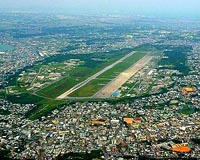| . |  |
. |
St. Louis MO (SPX) Jan 14, 2010 Boeing has delivered the last of four KC-767 aerial refueling tankers to the Japan Ministry of Defense, completing one of the International Tanker team's most significant milestones. Boeing's partner on the Japan Tanker program, Itochu Corp., handed over the KC-767 advanced tanker to Japan Ministry of Defense officials. Assigned to the 1st Airlift Wing of the Japan Air Self-Defense Force at Komaki Air Base, it is the third consecutive KC-767 tanker to be delivered to Boeing's Japan customer within the contracted schedule and budget. "Providing Japan with the fourth and final KC-767 tanker on-schedule and on-cost, as we did the previous two KC-767s, means a great deal to our company and our relationship with this important customer," said Dennis Muilenburg, president and CEO of Boeing Defense, Space and Security. "Because of these tankers, Japan now has the capability to perform vital self-defense, refueling and airlift missions. Also, when necessary, it possesses the capability to perform critical humanitarian and disaster-relief missions across the Pacific region and beyond using the KC-767." "We are proud to have been a partner in the successful delivery and implementation of the KC-767 aerial refueling tanker into the Japan Air Self-Defense Force," said Greg Kasagawa, executive officer and COO of the Aerospace and Industrial Systems Division of Itochu Corp. "The fleet of tankers is playing a significant and key role in the strategic self-defense needs of Japan." The fourth tanker flew to Japan on Dec. 20 from Boeing's tanker modification facility in Wichita, Kan. The KC-767 is a military derivative of the proven 767-200ER commercial widebody airplane built at Boeing's commercial production facilities in Everett, Wash. Boeing delivered the first three KC-767 tankers to Japan in February 2008, March 2008 and March 2009. The Japan KC-767 fleet is currently undergoing Operational Evaluation by the Japan Air Self-Defense Force, a process that should be completed early this year. The fleet achieved Initial Operational Capability (IOC) in March 2009. The tanker has an open architecture cockpit and is configured with the advanced Boeing air refueling boom and the associated Remote Aerial Refueling Operator (RARO) II system. Japan selected the convertible freighter configuration, allowing it to carry cargo or passengers while maintaining its primary role as an aerial tanker. With a convertible freighter interior, the Japan tanker can be rapidly converted from all-passenger to all-cargo configurations. Boeing also is on contract to deliver four KC-767s to the Italian Air Force. Three of the four tankers are in flight test, with the fourth airplane still being modified.
Share This Article With Planet Earth
Related Links Boeing The Military Industrial Complex at SpaceWar.com Learn about the Superpowers of the 21st Century at SpaceWar.com
 Clinton gets no commitment from Japan on ending air base row
Clinton gets no commitment from Japan on ending air base rowHonolulu, Hawaii (AFP) Jan 11, 2010 Secretary of State Hillary Clinton pressed her Japanese counterpart here Tuesday to stick by a deal on moving a controversial US air base, but got no commitment from Tokyo during the meeting. At hastily-arranged talks with Foreign Minister Katsuya Okada in Honolulu, Clinton said she had stressed the need to resolve the fate of the Futenma base on the southern Japanese island of Okinawa. ... read more |
|
| The content herein, unless otherwise known to be public domain, are Copyright 1995-2009 - SpaceDaily. AFP and UPI Wire Stories are copyright Agence France-Presse and United Press International. ESA Portal Reports are copyright European Space Agency. All NASA sourced material is public domain. Additional copyrights may apply in whole or part to other bona fide parties. Advertising does not imply endorsement,agreement or approval of any opinions, statements or information provided by SpaceDaily on any Web page published or hosted by SpaceDaily. Privacy Statement |